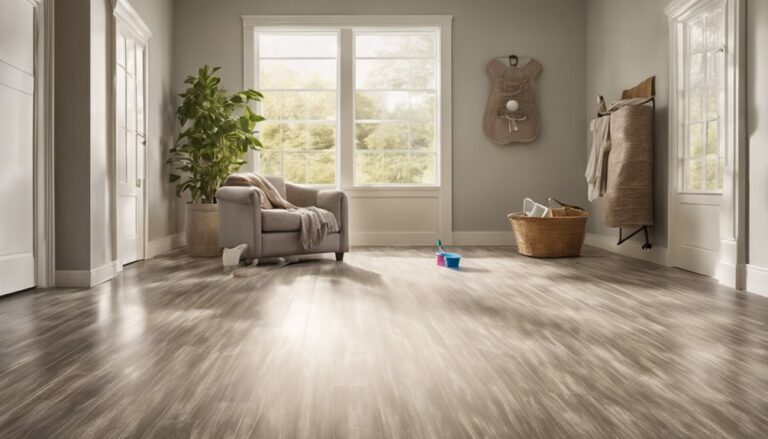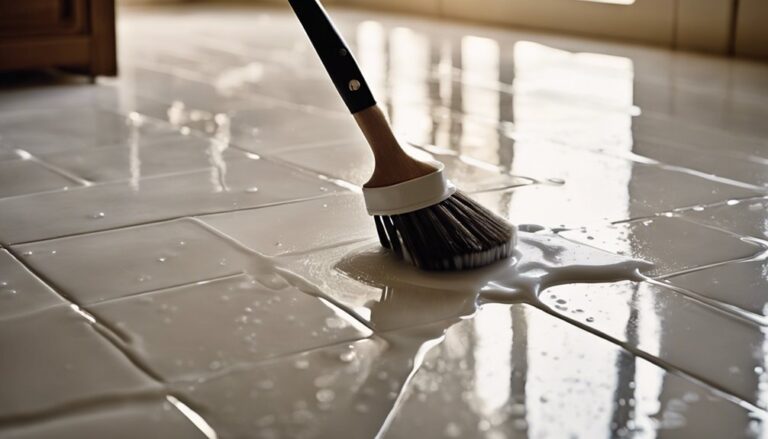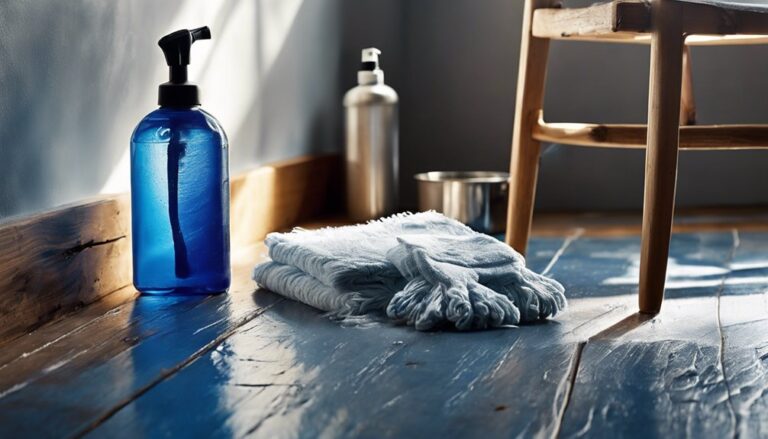You can't use a steam mop on hardwood floors without risking significant damage. The high temperature and moisture can warp the wood, especially if it's not properly sealed. Excess moisture may seep into seams, leading to long-term issues like mold growth or finish damage. Signs of potential damage include warping, gaps, and dull surfaces. Instead of steam mopping, consider using a slightly damp microfiber mop or a pH-balanced cleaner designed specifically for hardwood. Regular maintenance and alternative cleaning methods can preserve your floors' beauty and longevity. Explore additional safe practices to guarantee your hardwood remains in excellent condition.
Understanding Steam Mops

Although steam mops have gained popularity for their efficiency in cleaning various surfaces, understanding their functionality is important before using one, especially on hardwood floors. Steam mop technology utilizes high-temperature steam to sanitize and lift dirt, providing a chemical-free cleaning alternative. This method effectively eliminates germs and allergens, leading to a healthier home environment. One of the significant steam mop benefits is its ability to clean without excess water, minimizing the risk of damage to your hardwood. However, it's vital to confirm your floor is sealed properly, as unsealed wood can absorb moisture. By familiarizing yourself with your steam mop's features and adhering to guidelines, you can enjoy a cleaner, fresher living space while preserving your hardwood floors.
Hardwood Floor Types
When it comes to hardwood floors, understanding the differences between solid hardwood, engineered hardwood, and laminate pavimentazione is essential for maintenance decisions. Each type has unique characteristics that can impact how you care for your floors, especially when considering steam mopping. Knowing these distinctions will help you choose the right cleaning approach for your specific flooring type.
Solid Hardwood Characteristics
Solid hardwood floors are renowned for their durability and timeless appeal, making them a popular choice for homeowners seeking both aesthetics and longevity. One of the solid hardwood benefits is its ability to be refinished multiple times, allowing you to maintain its beauty for decades. With proper care, these floors can withstand heavy foot traffic and resist wear. Solid hardwood maintenance is essential; regular sweeping and occasional damp mopping will help preserve its finish. Avoid excessive moisture, as it can warp the wood. By understanding these characteristics, you'll appreciate the value solid hardwood adds to your home while enjoying the freedom to create a warm and inviting atmosphere. Choose wisely, and your investment will serve you well for years to come.
Engineered Hardwood Differences
Engineered hardwood offers a practical alternative to solid hardwood, especially for those seeking a balance between aesthetics and performance. Unlike solid wood, engineered hardwood is constructed from multiple layers, providing enhanced stability and moisture resistance. This makes it a great choice for areas with fluctuating humidity levels, such as basements or kitchens, where solid wood might warp or swell. You'll appreciate the authentic wood look, as the top layer features real hardwood veneer, ensuring beauty without sacrificing durability. When it comes to maintenance, you can clean engineered hardwood with a steam mop, but be cautious to avoid excess moisture. Overall, engineered hardwood combines the elegance of traditional wood with the resilience needed for modern living.
Laminate Flooring Features
While engineered hardwood provides a robust option for many homeowners, laminate flooring presents its own unique advantages. One of the standout features of laminate is its exceptional durability. Designed to withstand heavy foot traffic, scratches, and dents, laminate can often handle the demands of a busy household with ease. Plus, its moisture-resistant surface means you don't have to worry as much about spills or humidity. Regarding maintenance, laminate floors are a breeze. Regular sweeping and occasional damp mopping are all it takes to keep them looking fresh. You'll appreciate the freedom from the extensive upkeep often required by other flooring types. Ultimately, laminate flooring is an affordable, low-maintenance choice that doesn't compromise on style or functionality.
Risks of Using Steam Mops

Although steam mops can be an effective cleaning tool, using them on hardwood floors carries several risks that homeowners should be aware of. One of the primary concerns is steam damage, which can warp or buckle the wood over time. The intense heat and moisture from the steam can penetrate the seams, leading to potential long-term issues.
Here's a quick overview of the risks:
| Risk Type | Descrizione |
|---|---|
| Steam Damage | Can cause warping or buckling |
| Moisture Concerns | Excess moisture can seep into seams |
| Finish Damage | May strip or dull the wood finish |
| Slip Hazard | Increased moisture can be slippery |
| Mold Growth | Excess moisture can promote mold |
Understanding these risks can help you make informed decisions about cleaning your hardwood floors.
Signs of Damage to Watch For
When using a steam mop on hardwood floors, it's essential to keep an eye out for signs of damage. Look for scratches and scuffs on the surface, which can indicate wear from the mop's pad. Additionally, monitor for any warping or buckling, as these issues can signal moisture damage that needs immediate attention.
Scratches and Scuffs
As you maintain your hardwood floors, it's crucial to keep an eye out for scratches and scuffs, which can indicate potential damage. Even minor imperfections can detract from your floor's beauty and longevity. To guarantee scratch prevention, consider using furniture pads under heavy items and avoiding abrasive cleaning tools. Regularly inspect your floors for signs of wear, as early detection can save you from costly repairs. For scuff removal, a gentle approach is key; use a soft cloth with a suitable cleaner to lift marks without damaging the finish. By staying vigilant and proactive, you can preserve the natural elegance of your hardwood floors and enjoy their beauty for years to come.
Warping and Buckling
While maintaining the beauty of your hardwood floors, it is essential to watch for signs of warping and buckling, which can indicate serious underlying issues. These problems often stem from moisture damage and can compromise floor stability. Keep an eye out for these indicators to protect your investment.
| Signs | Descrizione | Azione richiesta |
|---|---|---|
| Cupping | Edges of boards rise | Assess moisture levels |
| Crowning | Center of boards bulges | Check humidity conditions |
| Gaps | Spaces between boards | Consider humidity control |
Recognizing these signs early can help you maintain the integrity of your floors and avoid costly repairs. Always prioritize proper cleaning methods to prevent moisture-related issues.
Alternatives to Steam Mopping
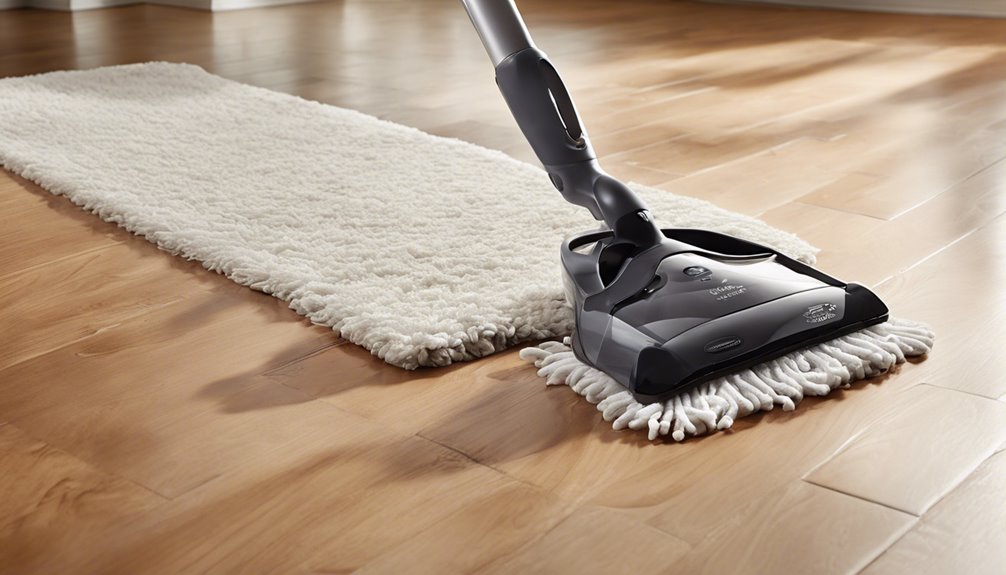
Although steam mops can effectively clean hardwood floors, there are several alternatives that might better suit your needs and preserve the integrity of your flooring. Here are some options to evaluate:
- Soluzione di aceto: Mix equal parts of water and white vinegar for a gentle yet effective cleaner.
- Panni in microfibra: Use these for dusting and damp cleaning without excess moisture.
- Dry Mopping: Regularly use a dry mop to keep dirt and debris at bay, protecting your finish.
- pH-Balanced Cleaners: Choose a cleaner specifically designed for hardwoods that won't damage the finish.
These methods can help you maintain your hardwood floors while ensuring their longevity and beauty.
Best Practices for Cleaning
When it comes to cleaning hardwood floors, employing best practices guarantees you maintain their beauty and durability. First, establish a regular cleaning frequency; sweeping or vacuuming weekly prevents dirt buildup that can scratch surfaces. For deeper cleans, use the best tools suited for hardwood—microfiber mops, gentle cleaning solutions, and soft-bristle brooms are ideal. Avoid excess water, as it can warp your floors; instead, lightly dampen your mop. If you decide to use a steam mop, make sure it's specifically designed for hardwood and follow the manufacturer's guidelines. Always test a small area first to verify compatibility. By adhering to these practices, you'll preserve the elegance of your hardwood floors while enjoying the freedom of a clean, inviting space.
Maintaining Hardwood Floors
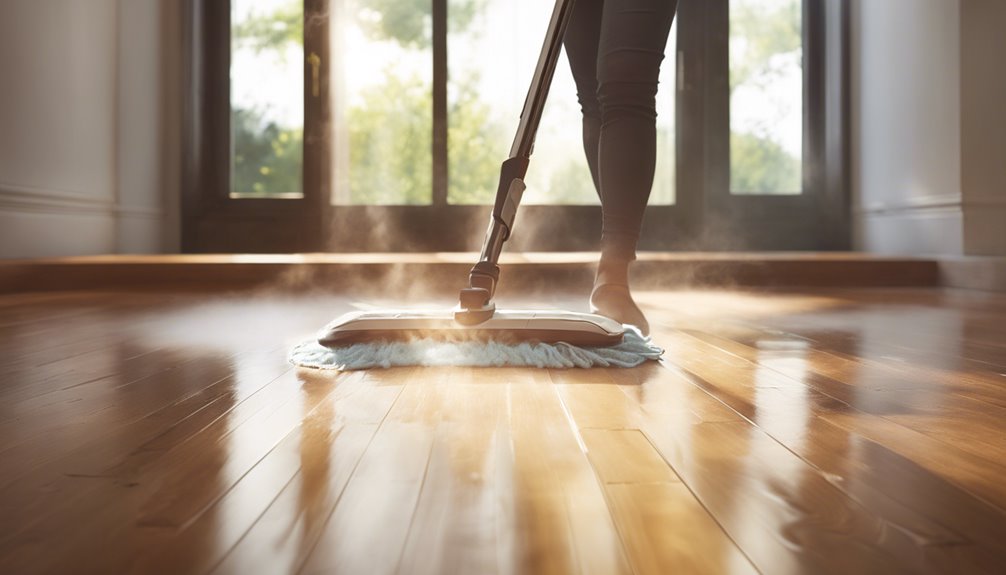
To keep your hardwood floors looking their best, regular maintenance is essential. Proper floor care not only enhances their beauty but also extends their lifespan. Here are some key tips to maintain your hardwood floors effectively:
- Regular Dusting: Use a microfiber mop or cloth weekly to remove dirt and debris.
- Frequenza di pulizia: Deep clean your floors every 1-2 months with a suitable wood cleaner.
- Avoid Water: Never soak your floors; excess moisture can damage the wood.
- Use Mats: Place mats at entryways to catch dirt and prevent scratches.
Domande frequenti
Can Steam Mops Clean Other Types of Flooring Effectively?
Yes, steam mops can effectively clean tile and laminate floors. They're great for removing dirt and grime without harsh chemicals. When using a steam mop on tile, the high temperature can sanitize and lift stains, while the grout gets a deep clean. For laminate floors, make sure you're using the right setting, as excessive moisture can damage them. Always check the manufacturer's guidelines to maintain your flooring's integrity and enjoy a fresh, clean home.
How Often Should I Clean Hardwood Floors With a Steam Mop?
When pondering the proper cleaning frequency for your hardwood floors, consider a consistent cadence. You should steam clean them every month, ensuring sparkling surfaces. For ideal maintenance tips, always check the humidity levels in your home, as excessive moisture can damage wood. Additionally, vacuuming or sweeping weekly will help keep dirt at bay, allowing your steam mop to shine. Embrace this routine, and you'll enjoy beautifully maintained hardwood floors without worry.
Are There Specific Steam Mop Brands Recommended for Hardwood Floors?
When choosing steam mop brands for hardwood floor compatibility, look for those specifically designed for delicate surfaces. Brands like Bissell and Shark offer models with adjustable steam settings, ensuring you can customize the cleaning intensity. These mops often feature microfiber pads that effectively lift dirt without damaging your floors. Always check user reviews to confirm their performance on hardwood, and make sure the mop you choose meets your cleaning needs while protecting your investment.
Can Steam Mops Remove Tough Stains From Hardwood Floors?
Imagine your hardwood floors shining like the sun after a rain. When it comes to stain removal, steam mops can be a double-edged sword. While they can effectively tackle light stains, tough ones might need a more delicate touch to avoid damaging your hardwood. For proper hardwood maintenance, it's best to test any method on a small area first, ensuring you preserve that beautiful floor without risking warping or finish loss.
What Temperature Does a Steam Mop Reach When Cleaning?
Steam mop temperature typically ranges between 200°F and 250°F. While this high temperature effectively sanitizes surfaces, it's essential to take into account hardwood floor safety. Prolonged exposure to such heat can damage your floors, leading to warping or finish issues. If you're using a steam mop, verify it's designed for hardwood and follow the manufacturer's guidelines. Always test a small area first to maintain the integrity of your beautiful hardwood floors while enjoying the cleaning benefits.


